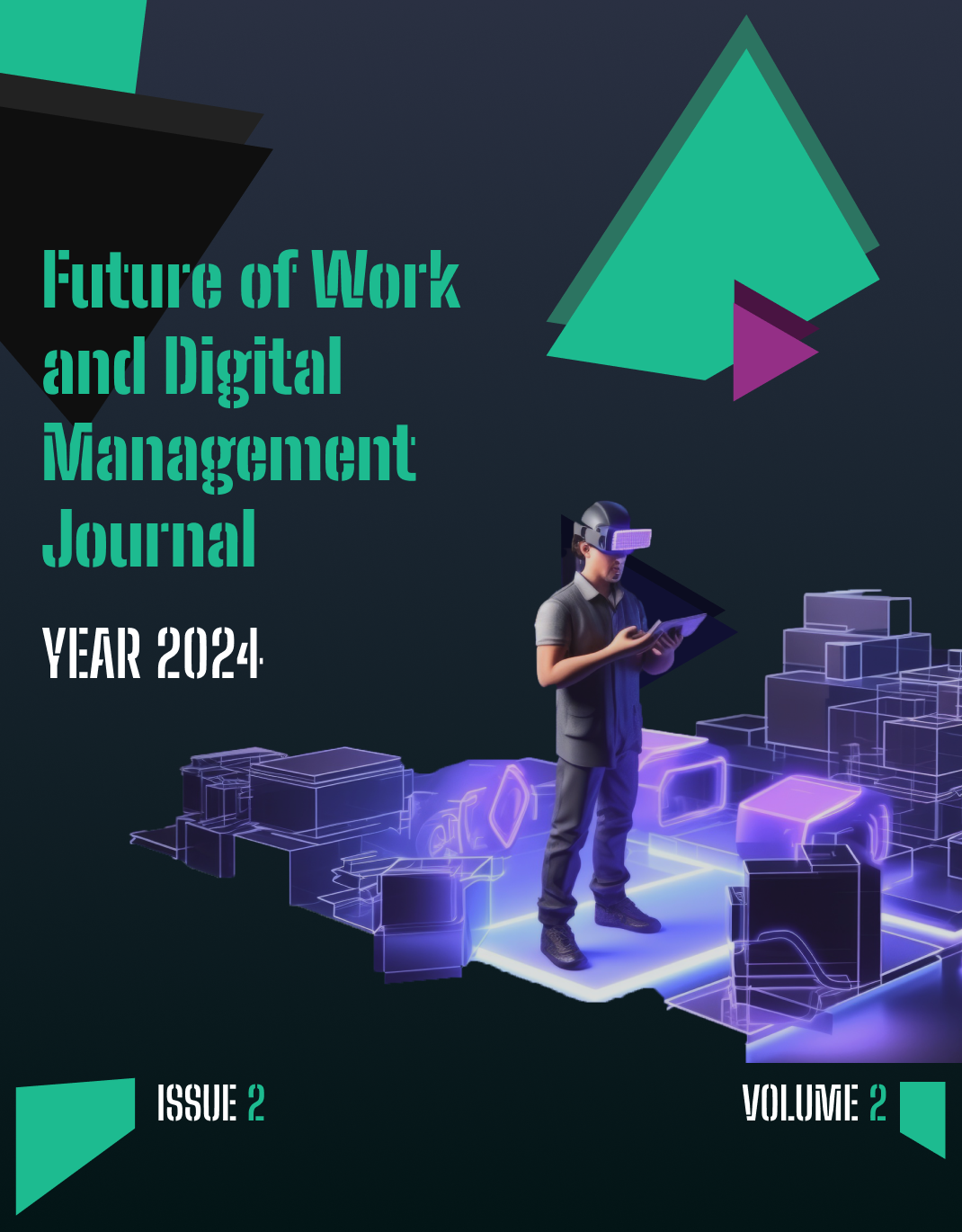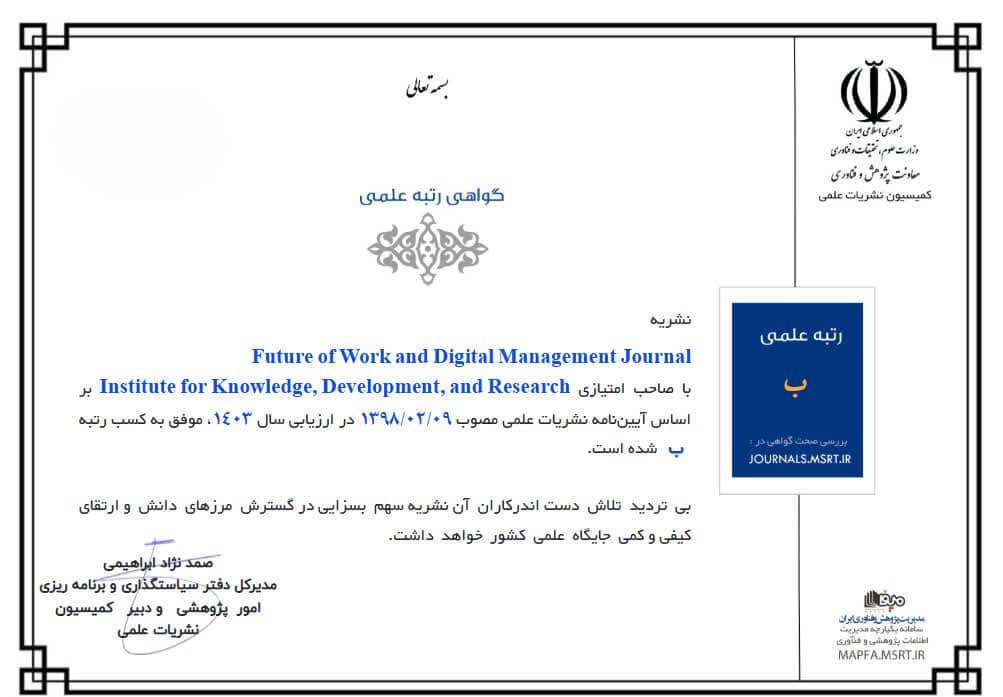Strategies for Implementing Process Automation with Artificial Intelligence in Startups
Keywords:
Artificial intelligence, process automation, startups, qualitative research, strategy prioritizationAbstract
This study aimed to identify and prioritize the key strategies that enable startups to effectively implement process automation using artificial intelligence (AI), addressing both organizational and technological dimensions. A qualitative research design was employed, using purposive sampling to select 21 participants, including founders, senior managers, and technical experts from technology-driven startups in Tehran, Iran. Data were collected through in-depth semi-structured interviews designed to explore participants’ experiences with AI-driven automation adoption. Interviews continued until theoretical saturation was reached. All interviews were transcribed verbatim and analyzed using NVivo 14 through open, axial, and selective coding to generate themes. After the qualitative phase, the identified strategies were subjected to quantitative prioritization; participants rated the relative importance of each strategy, and descriptive statistical analysis was performed using SPSS to establish ranking and mean scores. Six major strategic factors emerged: Strategic Alignment & Vision, Data Governance & Quality, Resource & Infrastructure Readiness, Technology Selection & Integration, Change Management & Culture, and Performance Measurement & Continuous Improvement. Ranking results indicated that Strategic Alignment & Vision was perceived as the most critical (M = 4.72; 22.5%), followed closely by Data Governance & Quality (M = 4.56; 21.7%) and Resource & Infrastructure Readiness (M = 4.31; 20.5%). Technology Selection & Integration (M = 4.18; 19.9%) and Change Management & Culture (M = 3.97; 19.0%) followed, while Performance Measurement & Continuous Improvement (M = 3.85; 18.6%) was ranked lowest but still recognized as essential for long-term success. The study provides a practical, evidence-based roadmap for startups seeking AI-driven process automation. Aligning automation with strategic vision, ensuring robust data governance, and preparing technical and financial infrastructure are foundational. Equally, careful technology selection and fostering cultural adaptability support effective and sustainable automation.
Downloads
References
[1] W. Suryathi and N. W. R. Mariani, "Revitalizing Marketing Strategies Through the Use of Artificial Intelligence: Analysis of the Effect of Personalization, Market Data Analysis, and Campaign Automation on Sales Conversions," Escalate, vol. 1, no. 02, pp. 101-108, 2024, doi: 10.61536/escalate.v1i02.25.
[2] N. Rane, S. Choudhary, and J. Rane, "Artificial Intelligence-Driven Corporate Finance: Enhancing Efficiency and Decision-Making Through Machine Learning, Natural Language Processing, and Robotic Process Automation in Corporate Governance and Sustainability," 2024, doi: 10.2139/ssrn.4720591.
[3] A. B. K. Rabbi, Jeelani, Idris, "AI integration in construction safety: Current state, challenges, and future opportunities in text, vision, and audio based applications," Automation in Construction, vol. 164, p. 105443, 2024/08/01/ 2024, doi: 10.1016/j.autcon.2024.105443.
[4] P. Pokala, "Artificial Intelligence in SAP S/4hana: Transforming Enterprise Resource Planning Through Intelligent Automation," International Journal of Scientific Research in Computer Science Engineering and Information Technology, vol. 10, no. 6, pp. 191-201, 2024, doi: 10.32628/cseit24106169.
[5] K. Ekuma, "Artificial intelligence and automation in human resource development: A systematic review," Human Resource Development Review, vol. 23, no. 2, pp. 199-229, 2024, doi: 10.1177/15344843231224009.
[6] M. Takhmasib, Lee, Hyuk Jae, Yi, Hwang, "Machine-learned kinetic Façade: Construction and artificial intelligence enabled predictive control for visual comfort," Automation in Construction, vol. 156, no. no, p. 105093, 2023/12/01/ 2023, doi: 10.1016/j.autcon.2023.105093.
[7] A. Semenova, "The Future of Work: Automation, Artificial Intelligence and Information Technology," E3s Web of Conferences, 2023, doi: 10.1051/e3sconf/202345105011.
[8] A. Rawashdeh, M. Bakhit, and L. Abaalkhail, "Determinants of artificial intelligence adoption in SMEs: The mediating role of accounting automation," International Journal of Data and Network Science, vol. 7, no. 1, pp. 25-34, 2023, doi: 10.5267/j.ijdns.2022.12.010.
[9] M. Mabungela, "Artificial Intelligence (AI) and Automation in the World of Work: A Threat to Employees?," Research in Social Sciences and Technology, vol. 8, no. 4, pp. 135-146, 2023, doi: 10.46303/ressat.2023.37.
[10] R. Bukartaite and D. Hooper, "Automation, artificial intelligence and future skills needs: an Irish perspective," European Journal of Training and Development, vol. 47, no. 10, pp. 163-185, 2023, doi: https://doi.org/10.1108/EJTD-03-2023-0045.
[11] Y. Himeur et al., "AI-big Data Analytics for Building Automation and Management Systems: A Survey, Actual Challenges and Future Perspectives," Artificial Intelligence Review, vol. 56, no. 6, pp. 4929-5021, 2022, doi: 10.1007/s10462-022-10286-2.
[12] A. R. A. M. Husain, A. Hamdan, and S. M. Fadhul, "The Impact of Artificial Intelligence on the Banking Industry Performance," in Future of Organizations and Work After the 4th Industrial Revolution: The Role of Artificial Intelligence, Big Data, Automation, and Robotics, 2022, pp. 145-156.
[13] H. Saiya, S. Doshi, J. Seth, V. Badgujar, and G. Kalme, "Automation of Supply Chain Management for Healthcare," in Progresses in Artificial Intelligence & Robotics: Algorithms & Applications. ICDLAIR 2021, vol. 441. Cham: Springer, 2022.
[14] L. Zhang and H. Li, "Artificial Intelligence in Cost Estimation for Construction Projects," Automation in Construction, vol. 125, p. 103573, 2021.
[15] D. E. Micle et al., "Research on Innovative Business Plan: Smart Cattle Farming Using Artificial Intelligent Robotic Process Automation," Agriculture, vol. 11, no. 5, p. 430, 2021, doi: 10.3390/agriculture11050430.
[16] S. S. Kamble, A. Gunasekaran, A. Ghadge, and R. Raut, "A performance measurement system for industry 4.0 enabled smart manufacturing system in SMMEs- A review and empirical investigation," International Journal of Production Economics, vol. 229, p. 107853, 2020/11/01/ 2020, doi: 10.1016/j.ijpe.2020.107853.
[17] L. D. Hollebeek, D. E. Sprott, and M. K. Brady, "Rise of the Machines? Customer Engagement in Automated Service Interactions," Journal of Service Research, vol. 24, no. 1, pp. 3-8, 2021, doi: 10.1177/1094670520975110.
[18] A. R. Wheeler and M. R. Buckley, "The current and future states of automation, artificial intelligence, and machine learning," in HR without People?: Emerald Publishing Limited, 2021, pp. 29-44.
[19] M. A. Mohammed, M. A. Mohammed, and V. A. Mohammed, "Impact of Artificial Intelligence on the Automation of Digital Health System," International Journal of Software Engineering & Applications, vol. 13, no. 6, pp. 23-29, 2022, doi: 10.5121/ijsea.2022.13602.
Downloads
Published
Submitted
Revised
Accepted
Issue
Section
License
Copyright (c) 2024 Sina Fayezi, Mohammad Taghi Karimi (Author)

This work is licensed under a Creative Commons Attribution-NonCommercial 4.0 International License.








